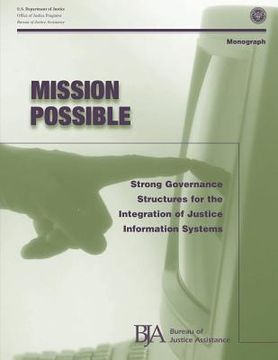Mission Possible: Strong Governance Structures for the Integration of Justice Information Systems (in English)
Synopsis "Mission Possible: Strong Governance Structures for the Integration of Justice Information Systems (in English)"
Public confidence in the United States justice system is negatively impacted by the absence of an integrated justice information system that can share information and provide information that is not only timely, but also accurate and complete. To enhance the efforts of local jurisdictions engaged in justice information systems integration and to encourage similar efforts in other jurisdictions, Public Technology, Inc. (PTI) conducted a study that examined justice integration governance structures at the local government level. The study builds upon the recommendations from a series of U.S. Department of Justice-sponsored conferences that focused on local and state information system integration. Surveys were completed by 251 jurisdictional representatives of suburban, urban, and rural areas throughout the United States. The majority of respondents were engaged in some aspect of information systems integration with other departments and/or agencies, and most systems were integrated with their state justice system. However, one-third had no integration efforts underway and no governance structure in place to facilitate integration. Some of the major findings of the study were: Funding is a major reason that jurisdictions are not engaged in justice information system integration and that they have not established governance structures; Other obstacles are turf issues and lack of technology; Local jurisdictions believe that the federal and state governments can best assist them by providing funding for their integration efforts. Regional governments could help best by providing strategic planning and funding assistance; and local governments could best assist by providing the appropriate personnel and implementation support; The most common type of governance structure was established through a cooperative agreement; Governance structures are most often initiated by persons directly affected by the structure and/or by key advocates; The roles and responsibilities of a governance board vary, but the most common include reviewing projects and prioritizing initiatives; Law enforcement is most commonly the agency involved in integration efforts. The top three information systems that respondents integrated were records management, offender history, and computer dispatch systems; The majority of respondents felt having a governance structure was a benefit to integration; In jurisdictions that have not established a governance structure, integration tends to be managed by an individual agency. Based on their experiences with justice information system integration, respondents offered a number of suggestions for advancing these efforts. In establishing local governance structures that can facilitate the integration of justice information systems, several central themes emerged from the recommendations: Ensure equal involvement/participation from all agencies/jurisdictions involved; Explore and secure funding; Set realistic goals and objectives with a reasonable implementation timeframe; Keep ongoing, open lines of communication with all agencies/jurisdictions involved; Have unconditional support of county boards/city councils/elected officials; Have well-trained technology users; Standardize and network all software, hardware, and protocols. Well-defined governance structures improve the justice information integration process by enhancing communication, establishing guidelines and policies, reducing turf battles, and fostering coordination and cooperation. Such structures consolidate and streamline information integration. Governance structures also can play a crucial role in securing funding for local system integration efforts. Technology, by itself, cannot solve all system integration problems, and even the best-equipped integration effort will soon bog down without an effective governing body to chart its course.

